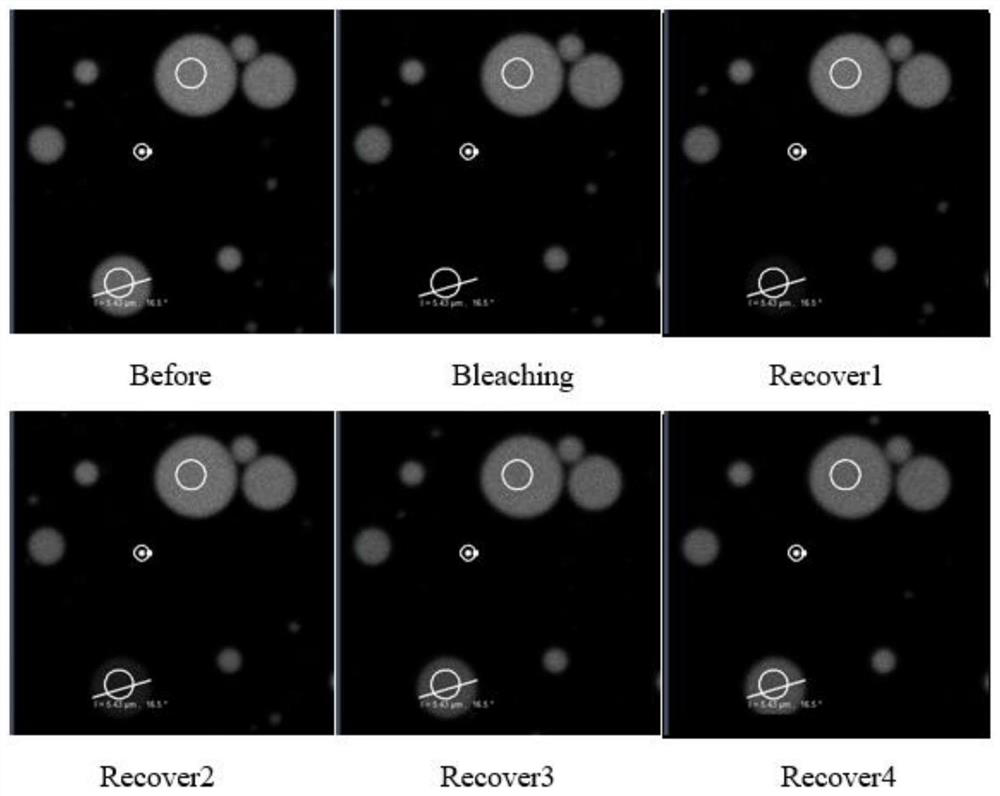Method for characterizing flowability of specific components of emulsion
A technology with specific composition and fluidity, which is applied in the field of food analysis to achieve better fixation effect, short detection time, high intuitiveness and accuracy
- Summary
- Abstract
- Description
- Claims
- Application Information
AI Technical Summary
Problems solved by technology
Method used
Image
Examples
Embodiment 1
[0046] Emulsion in the milk-peanut aqueous phase oil extraction process that embodiment 1 food processing technology produces
[0047] (1) Preparation of observation samples: The peeled peanuts were crushed into pulp by a traditional Chinese medicine grinder, and the emulsion and free oil were generated through one alkali extraction and two alkali extractions.
[0048] Take 10 μL of emulsion samples, mix them with 0.1 mg / mL Nile Red at a ratio of 5:1 (v / v), and stain in the dark for more than 30 minutes, take 2 μL of samples and place them on a gridded lysine-based glass slide quickly and gently cover with a coverslip.
[0049] (2) Adjust the working parameters of the laser confocal microscope:
[0050] Excited by an Ar+ laser with an excitation wavelength of 514nm, observed with a ×63 oil lens, the scanning range Frame Size (nm) is 512*512, and the rest of the parameters are the same as Table 1, that is, the range of emitted light and reception is 538-740nm, and the pinhole ...
Embodiment 2
[0055] Example 2: Natural milk - breast milk
[0056] Natural milk includes all natural milk, such as human milk (also called breast milk) and other non-human milk, and breast milk is selected as an example in this embodiment. The fat in breast milk exists in the form of milk fat globules of different sizes. The milk fat globule membrane (MFGM) accounts for about 2% to 6% of the fat globule weight. It is composed of phospholipids, glycolipids, proteins, and rich in cholesterol and sheath. The loose network structure composed of lipid raft domains of phospholipids has a complex structure. Among them, the crescent area refers to the protruding substance attached to the human milk fat globule HMFGs, which is interpreted by related literature as the cytoplasmic remnants of the lactating cells connected to the HMFGs when they are secreted. It is named the crescent area because of its shape, precisely Determining the origin of the cytoplasmic crescent on fat globules may further el...
Embodiment 3
[0068] Example 3: Nanoemulsions - Nanoemulsions were prepared by dissolving catechins and powdered zein in ethanol.
[0069] Take 2g of catechin and powdered zein respectively, dissolve them in 20g of ethanol, stir to fully mix. Take 10 μL samples, mix them with 0.1 mg / mL Nile Blue at 5:1 (v / v), and stain them in the dark for more than 30 minutes. Take 2 μL samples and place them on gridded lysine-based glass slides. Quickly and gently cover with a coverslip.
[0070] (2) Adjust the working parameters of the laser confocal microscope:
[0071] Excited by a He-Ne laser with an excitation wavelength of 633nm, observed with a ×63 oil immersion lens, the scanning range FrameSize (nm) is 512*512, and the rest of the parameters are the same as in Table 1, that is, the emission light receiving range is 538-740nm, and the pinhole is 128.1AU, the gain value is 700.
[0072] (3) Set the bleaching parameters of the probe:
[0073] Select the bleaching area size of 10pixel to bleach t...
PUM
| Property | Measurement | Unit |
|---|---|---|
| Particle size | aaaaa | aaaaa |
| Wavelength | aaaaa | aaaaa |
| Particle size | aaaaa | aaaaa |
Abstract
Description
Claims
Application Information
 Login to View More
Login to View More - Generate Ideas
- Intellectual Property
- Life Sciences
- Materials
- Tech Scout
- Unparalleled Data Quality
- Higher Quality Content
- 60% Fewer Hallucinations
Browse by: Latest US Patents, China's latest patents, Technical Efficacy Thesaurus, Application Domain, Technology Topic, Popular Technical Reports.
© 2025 PatSnap. All rights reserved.Legal|Privacy policy|Modern Slavery Act Transparency Statement|Sitemap|About US| Contact US: help@patsnap.com



